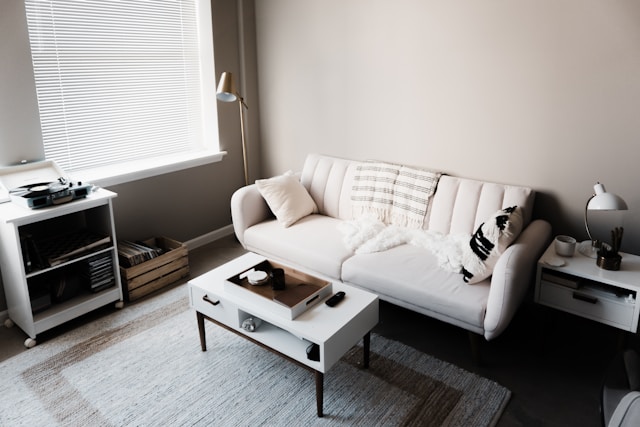The living room serves as the heart of the home. However, decorating this central area can often feel daunting. Even a small misstep can disrupt the harmony of the room’s design. Achieving a balance between functionality and visual appeal is key, but this becomes much simpler when you’re aware of common pitfalls to avoid. With the right approach, creating a beautifully designed and practical living room is well within reach.
Undersized Rug
The right rug can truly transform your living room. It anchors your furniture and helps define the living area, especially in open-plan spaces. Before you start shopping, take measurements of your living room and the main pieces of furniture within it.
Ideally, the rug should be large enough to fit all the key furniture pieces on top. If space is limited and this isn’t possible, opt for a rug that is slightly wider than your sofa, ensuring the front legs of the sofa and smaller furniture items like side tables or stools can rest on it.
Choosing the Incorrect Sofa
A comfortable living room begins with the right sofa. The couch is the focal point of the space. It plays a central role in both style and function. Selecting the perfect sofa involves more than just picking a preferred color or estimating dimensions.
Factor in the scale, the room’s layout, how people will move through the space, and how you plan to use it before settling on the ideal size and design for your home. Check out Kasala for a wide selection of high-quality and stylish sofas that will elevate your living room’s design.
It’s Boring
We naturally feel drawn to spaces that seem to have a story to tell. When designing a room, aim to make it reflect your personality and feel uniquely yours. A helpful approach is to ask whether it’s a space anyone could have, or if it feels overly coordinated, and adjust from there.
Incorporating a mix of finishes, fabrics, and textures is essential for crafting a layered, dynamic look. For example, if all your tables are wooden, whether it’s side tables, a console, or a coffee table, try swapping one for a piece made of glass or metal to introduce variety.
Dim Lighting
Lighting plays a crucial role in design. Aim to maximize the amount of natural light in your space and avoid obstructing it with poorly positioned curtains or accessories. For artificial lighting, incorporate multiple light sources to brighten your room effectively. Choose appropriately sized and strategically placed lamps or sconces to complement natural light. Adding dimmers to ceiling or overhead lights can provide flexibility. Selecting the right lighting fixtures helps create a unified and polished look for your décor.
Congestion and Clutter
Your furniture should complement your space by making it both attractive and practical. It’s important to leave enough room for movement and natural flow. A space should never feel crowded or confined. Often, the issue isn’t having too much furniture but rather how it’s arranged.
Start by shifting a few pieces to new positions. If the area still feels tight, consider removing one item entirely. You might be surprised at how significantly this small adjustment can improve the room. Overloading a space with furniture not only makes it appear smaller but also makes it harder to move through comfortably.
Endnote
Transforming your living space can be an enjoyable and imaginative endeavor. Avoiding frequent decorating errors preserves both the practicality and aesthetic appeal of your home. By sidestepping these typical missteps, you can design a home that’s not only functional but also beautifully reflects your personal style.








Leave a Reply